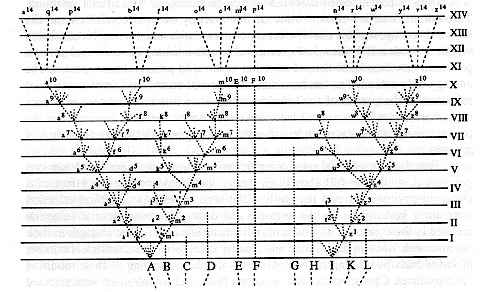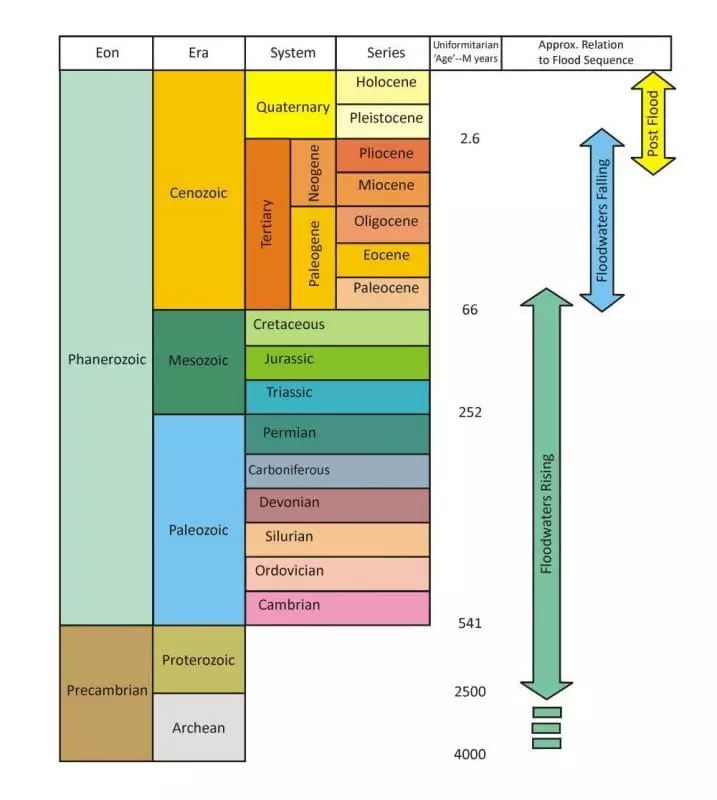[Originally published as the second half of Timeframes of Evolution]
These geobiological conflicts compelled Darwin to take a different approach to justify “long periods of time.” Darwin turned to a biological, rather than geological, model.
Biological Time Model

In the only diagram in The Origin of Species (pictured above), Darwin illustrates the relationship between natural selection and long periods of time. Acquiring variations and passing them from one generation to the next is a time-consuming process. As Darwin explains:
As natural selection acts solely by accumulating slight, successive, favorable variations, it can produce no great or sudden modification; it can act only by very short and slow steps.
However, even though Lyell cautioned against doing so, Darwin synchronizes geological timeframes with biological generations. In the description of The Origin of Species diagram, Darwin links the relationships between biological generations, geology, and time, noting:
“In the diagram, each horizontal line has hitherto been supposed to represent a thousand generations, but each may represent a million or hundred million generations, and likewise a section of the successive strata of the earth’s crust.”
Ironically, while inferring biological generations represents some timeframe of evolution, Darwin never quantified his concept. And the terms “interval” and “period” are used interchangeably. In the first edition, Darwin described these as:
… each horizontal line has hitherto been supposed to represent a thousand generations, but each may represent a million or hundred million generations.
Model Adjustment
By the sixth and final edition of the book, Darwin mixed the sentence to:
“The intervals between the horizontal lines in the diagram, may represent each a thousand or more generations.”
Darwin vaguely infers the concept deep time to a number of generations to “get” an assumed number of species, writing:
By continuing the same process for a greater number of generations (as shown in the diagram in a condensed and simplified manner), we get eight species, marked by the letters between a14 and m14, all descended from (A).
Using inferences and metaphors, Darwin uses circular reasoning to infer how deep time makes natural selection plausible. Darwin inextricably tethered natural selection to deep time.
Long Periods of Time Logic
In The Origin of Species, the terms “periods” (369), “lapsed time” (18), “periods of time“ (13), and “intervals of time” (27) appear a total of 427 times. Beyond these terms, Darwin used numerous biological constructs to justify deep time.
In using his logical approach, for example, Darwin viewed deep time resolving the improbability of natural selection. Using the eye as an example, Darwin reasoned:
“To suppose that the eye… could have been formed by natural selection, seems, I freely confess, absurd in the highest degree… [But] let this process go on for millions of years… may we not believe that a living optical instrument might thus be formed?”
Viewing deep time differently, Darwin used it as a logical excuse for the perceived incompleteness of the fossil record. Darwin argued that the incompleteness stemmed from the vastness of time and the rarity of preservation, writing:
Of this history we possess the last volume alone, of which only here and there a short chapter has been preserved; and of each page, only a few lines.
For Darwin, deep time logically resolves the improbability of natural selection yet dissolves the probability of a complete fossil record. In other words, he relied on philosophical-centric management.
However, Darwin’s reasoning ultimately led to circular dead ends.
Circular Reasoning
Such circular reasoning involves a logical fallacy since the conclusion of an argument is assumed in the premise, even though the conclusions may be either true or false. Alone, circular reasoning does not prove anything.
For a conclusion to be scientifically valid, the reasoning must be founded on objectively definable independent evidence.
Factual or scientific conclusions based on premises without objective evidence are at risk of being a logical fallacy. Circular reasoning conclusions may only be restatements of the premise.
Circular reasoning remains pervasive throughout evolutionary literature, particularly in radiometric and molecular clock dating approaches, as will be discussed. However, using circular reasoning can give the illusion of a scientific argument.
Interestingly, the concept of linking long time periods to natural selection was initially introduced as a principle of evolution by an English economist.
Darwin, a Time-Model Critic
The English economist Thomas Robert Malthus influenced Darwin’s theory of evolution on multiple levels, specifically concepts of growth and time. Darwin credits Malthus’s population growth concept for understanding how natural selection could work.
However, Darwin eventually became a critic of his own biological time-model, writing:
“New species have come on the stage slowly and at successive intervals; and the amount of change, after equal intervals of time, is widely different in different groups.”
Observations of “widely different” time intervals between “different groups” complicated how Malthus’s population concept might apply to natural selection.
However, even without a scientifically valid understanding of evolution timeframes, interest in Darwin’s theory had already launched a cultural revolution.
HMS Challenger Search
In 1872, the British Parliament commissioned the HMS Challenger to search for Darwin’s missing evidence. After four years of work, however, Challenger’s global search for Darwin’s missing evidence ended.
At the time, marine life deep in the oceans was expected to demonstrate evidence of Darwin’s missing transitional links. However, while the voyage proved to be a successful oceanographic mission; the search for evidence to support Darwin’s theory was a bust.
The crew discovered a vast diversity of organisms at every depth, but evidence of Darwin’s missing links remained beyond their reach. And notably, evidence to support Darwin’s “long periods of time” concept never materialized.
By the end of the nineteenth century, interest in Darwin’s theory had nearly vanished. However, an astonishing biological rediscovery at the turn of the century changed everything.
A few decades later, developments in nuclear technology opened new avenues to scientifically study the history of Earth’s biosphere. A new era had finally emerged, equipped for experimenting in the fields of geology and biology in support of Darwin’s theory.
Twenty-First Century Evolutionary Timeframes
 By the twentieth century, the geological concepts of Eons, Eras, Periods, Epochs, and Ages emerged as popular evolutionary timeframes. These were introduced earlier by Giovanni Arduino during the eighteenth century and subsequently developed into evolution’s de facto timeframes.
By the twentieth century, the geological concepts of Eons, Eras, Periods, Epochs, and Ages emerged as popular evolutionary timeframes. These were introduced earlier by Giovanni Arduino during the eighteenth century and subsequently developed into evolution’s de facto timeframes.
Modern illustrations of these timeframes are known as stratigraphic charts. Eons are the most extended periods, spanning hundreds of millions to billions of years from their beginnings. Ages, the shortest of periods, are inferred to span millions to tens of millions of years.
Stratigraphic geological studies form the foundation for developing the widely used chronostratigraphic charts. Chrono refers to time, and stratigraphy refers to the study of layered rocks (strata). Finding scientific evidence for Darwin’s “long periods of time” finally seemed probable.
Since then, multiple organizations have published different types of chronostratigraphic charts.
Geological Dating Challenges
Charts published by the International Commission on Stratigraphy (ICS) are considered the most authoritative. However, the elements used to construct all charts have known uncertainties. Currently, a consensus on managing uncertainties has yet to be developed. In acknowledging these uncertainties, ICS includes the following disclaimer on its charts:
“Numerical ages are subject to ongoing revision and do not define unitss in the Phanerozoic and the Ediacaran…”
Modern evolutionary timeframes in chronostratigraphic charts depict layers of assumptions and inferences; in short, logical uncertainties.
However, an evolutionary timeframe of Earth’s biosphere requires a composite synthesis of geological and biological evidence.
Earth’s Biosphere
In 1875, Austrian geologist Eduard Suess introduced the term “biosphere” in his work, Die Entstehung der Alpen [The Origin of the Alps]. Suess viewed Earth’s biosphere as the place on Earth’s surface where life dwells.
Earth’s biosphere is likened to a snapshot of a two-sided coin. One side is abiotic, inert forces, and the other side is biotic, reproductive intelligence machines. However, while the analogy is valid, since each side uses different types of data for measuring time, synchronizing conflicts are inevitable.
In geology, stratigraphic observations and radiometric dating provide the objective evidence to study time. However, erosion, non-deposition, and tectonic disruption fragment geological observations.
In biology, modern biotechnological advances have revolutionized access to objective evidence to examine the timing of past events. However, phylogenetic trees, molecular clocks, and pedigree-based mutation rates require assumptions.
While timeframes can be formulated with geological and biological data, their timeframe data differ greatly. Therefore, evolution scientists must use a systematic approach to synchronize these two different types of data sets.
To synchronize these diverse data sets, evolution scientists use epistemic reasoning. But this gets tricky.
Epistemic Reasoning
The root term, epistemology, originates from the Greek ἐπιστήμη (episteme, meaning knowledge or understanding) and λόγος (logos, meaning study of). Essentially, epistemology can be used to synchronize acquired knowledge.
A massive knowledge base of geological and biological data has been acquired over the past half-century. Epistemic logic is regularly used in evolutionary studies.
However, no scientific organization has developed a consensus on how to apply epistemic reasoning in evolution studies. Developing timeframes of evolution is the wild-west side of science. As a Yale geologist, Alec Brenner, noted in LiveScience:
Unravelling Earth’s 4.5-billion-year history with rocks is tricky business.
The issues challenging the development of evolution timeframes begin with the uncertainties in the data and the uncertainties in the reasoning process.
In the late 1990s, TimeTree, a scientific evolution organization, was founded to compile published geological and biological data into a computer database.
TimeTree
TimeTree offers the most comprehensive and publicly available tool to apply epistemic reasoning for exploring the history of Earth’s biosphere.
The National Science Foundation, NASA Astrobiology Institute, and the Science Foundation of Arizona support the TimeTree project. Currently hosted at Temple University, the database includes over 4,200 published molecular phylogenies covering more than 148,000 species.
David Attenborough incorporated TreeTime’s timeframe graph (pictured) in his Rise of Animals: Triumph of the Vertebrates series. The BBC initially aired the documentary series in 2013. It is still currently available on Netflix, YouTube TV, Amazon Prime, and Apple TV.
TimeTree is currently the de facto authoritative source for proposing the timeframes of evolution. However, a measure of the known uncertainties is currently not a practice with published timeframes.
The discovery of living fossils and soft tissue preservation in fossils continues to challenge even the most advanced timeframes of evolution.
Biological Timeframe Challenges
The term, living fossils, was coined by Darwin in The Origin of Species. Darwin called living fossils “quiet observers” – relics untouched by natural selection.
Living Fossils
Species, once thought to be extinct, discovered contemporarily but seemingly unchanged from their fossilized forms, are known as living fossils. Darwin considered the Lungfish and the Platypus as examples.
More recently, the Coelacanth, once thought extinct for millions of years, was discovered off the coast of South America in 1938. Horseshoe crabs and ginkgo trees are other popular living fossil examples.
Living fossils force a new reckoning over assumptions about tempo, mode, directionality, and the scientific validity of biological evolution.
Stabilizing selection is one popular logical explanation for living fossils. Some evolution scientists assume these are reflective of a new, yet undefined, type of evolutionary process. The concept of living fossils is highly debated among evolutionary scientists.
Soft-Tissue Preservations
In a 2007 discovery, Mary Schweitzer, an American paleontologist, revolutionized the scope of modern evolution studies. In a T Rex dinosaur fossil, thought to be millions of years old, Schweitzer reported finding evidence of flexible blood vessels and red blood cells.
This level of preservation had long been understood to be impossible. Proteins and soft tissues degrade via hydrolysis and oxidation, even in cold, anoxic conditions. Preservation over millions of years defies known chemical kinetics.
But an increasing number of similar discoveries, once shocking, continue to upend basic assumptions about fossils. This level of preservation suggests either exceptional preservation or prompts a reevaluation of long-standing fossil age assumptions.
Methuselah
Methuselah, a member of the Pinus longaeva species, the Earth’s oldest tree, currently living in White Mountains, California, is credited as the Earth’s oldest tree. Based on tree-ring analysis (dendrochronology), Methuselah’s estimated age is 4,857 years.
The scientific validity of radiometric and molecular clock dating methods, with all its uncertainties, need to include the following disclaimer, too:
“Numerical ages are subject to ongoing revision…”
Genesis
Time holds the scaffolding of every physical law in the universe. Yet, understanding the history of time seems to remain beyond the reach of science.
A “beginning” in the history of time is universally recognized time principle. While never challenging Moses’s “beginning” concept, the search for deep time remains a logical uncertainty.
Sir Isaac Newton, an English physicist and mathematician, the most recognized scientist of the scientific revolution, Newton, declared –
Truth is ever to be found in the simplicity, and not in the multiplicity and confusion of things.
Whatever the timeframes of evolution might be, the probability of any of them being simple seems uncertain and increasingly improbable.







